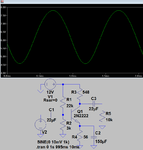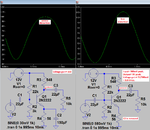MahmoudHassan
Full Member level 6
Hello
Dear All,
i tried to design a simple CE amplifier but i found that it amplifies the positive half cycles more than negative ones !!!What possible faults that may cause this error ?
The gain is supposed to be 20 (but it is 24 after design acceptable)
Rin > 2Kohm
Beta for this transistor ~= 255
Is = 14.34 *10^-15 A
Freq = 20 Hz -- 20 Khz
Attached figures for the design and output signals using parametervaring the input voltage ,when is the input voltage is larger than 0.5mV the the amplifier starts to amplify the positive half cycle more than the negative one
i hope you can give me reasons for this fault so that i can improve this design
(This is not HW , iam studying Fundamentals of microelectronics self study and trying to design example in chapter 5 )
Thanks a lot
Best Regards,
Mahmoud


Dear All,
i tried to design a simple CE amplifier but i found that it amplifies the positive half cycles more than negative ones !!!What possible faults that may cause this error ?
The gain is supposed to be 20 (but it is 24 after design acceptable)
Rin > 2Kohm
Beta for this transistor ~= 255
Is = 14.34 *10^-15 A
Freq = 20 Hz -- 20 Khz
Attached figures for the design and output signals using parametervaring the input voltage ,when is the input voltage is larger than 0.5mV the the amplifier starts to amplify the positive half cycle more than the negative one
i hope you can give me reasons for this fault so that i can improve this design
(This is not HW , iam studying Fundamentals of microelectronics self study and trying to design example in chapter 5 )
Thanks a lot
Best Regards,
Mahmoud



